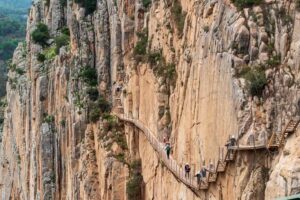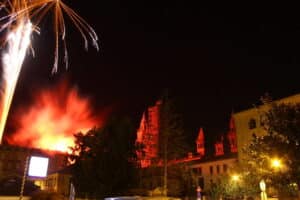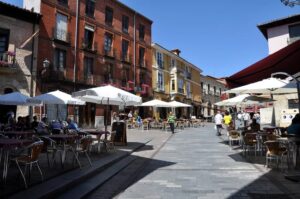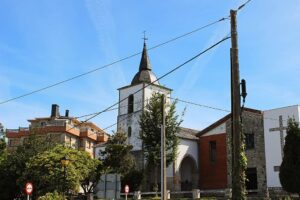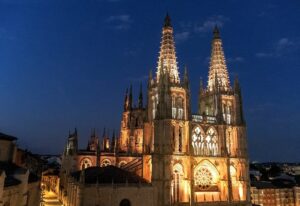
The Camino de Santiago, with its numerous routes, offers a unique experience for all those seeking a connection with history, nature, and spirituality. Among these routes, the English Way to Santiago from Ferrol is one of the most well-known. But, have you heard of the Atlantic Way? This lesser-travelled route offers a different yet equally enriching experience.
At Mundiplus, experts in Camino de Santiago tours, we explore how the Atlantic Way can be a charming alternative for those seeking coastal landscapes, tranquillity, and a closer connection with nature. Discover its charms and why it could be the perfect choice for your next adventure.
Índice de contenidos
Mundiplus, specialists in the Camino de Santiago
Before we continue, we should note that this is a route we don’t directly manage. However, we are delighted to provide you with information that you’ll find valuable.
Exploring the Camino de Santiago offers diverse routes filled with history and natural beauty.
- One notable option is the Portuguese Coastal Way experience, a coastal route combining maritime landscapes and charming villages. This route, starting in Porto, offers a fascinating variation from Baiona.
- The Portuguese Way from Baiona joins the coastal route, providing a unique experience for pilgrims.
- On the other hand, the French Way to Santiago from Roncesvalles is one of the most traditional and popular routes, known for its mountainous landscapes and rich history.
- For those planning their journey, it is helpful to consult a map of the Portuguese Coastal Way to plan the stages and fully enjoy the journey.
Origin and history of the Atlantic Way
The Atlantic Way dates back to ancient times, when coastal routes were used by traders and pilgrims to avoid the difficult inland mountains. Although less known, this route has witnessed the passage of numerous pilgrims who, attracted by its beauty and serenity, chose to follow its path parallel to the Atlantic Ocean.
From its beginnings, it has been a path of cultural exchange, where Galician and Cantabrian traditions blend.
Pilgrims choosing this route seek not only a connection with nature but also a more intimate spiritual experience, away from the crowds. The presence of ancient monasteries and shrines along the way highlights its religious significance over the centuries.
Another unique aspect is that it can be considered as a route that combines the English Way with the Camino to Finisterre.
Comparison between the Atlantic Way and the English Way

While they may seem similar, the reality is that the Atlantic Way and the English Way offer two completely different experiences. Each route has its own unique characteristics and attractions, making them suitable for different types of travellers.
Below, we compare both routes in terms of distances and stages, landscapes and environment, and infrastructure and services.
Distances and stages
- The Atlantic Way covers approximately 190 kilometres (73 if ending in Santiago), divided into ten stages (4 if ending in Santiago de Compostela).
- In contrast, the English Way has:
- A length of around 120 kilometres if starting in Ferrol.
- A length of around 75 kilometres if starting from A Coruña (hence the possible confusion, depending on the starting point).
Both routes are accessible for most walkers. However, the Atlantic Way may offer a slightly longer experience, allowing for a deeper immersion in the journey.
Landscapes and environment
One of the main differences between these routes lies in their landscapes.
- The Atlantic Way is characterised by its stunning coastal views, with the Atlantic Ocean as a constant companion. It offers a maritime atmosphere, beaches, and cliffs.
- On the other hand, the English Way to Santiago from Ferrol offers a mix of rural and urban landscapes, with picturesque towns, forests, and sections bordering the estuary of Ferrol.
Infrastructure and services
In terms of infrastructure, as you might expect, the English Way has better-developed services, with numerous accommodations, restaurants, and information points. Being one of the most frequented routes, pilgrims will find everything they need for a comfortable journey.
In contrast, the Atlantic Way offers a quieter and more secluded experience. While it has a range of accommodations and services, these are less abundant, offering a more rustic and authentic atmosphere. For those looking to disconnect and enjoy a quieter adventure, this route is ideal.
Conclusions
In conclusion, both the Atlantic Way and the English Way offer unique experiences for pilgrims. The choice will depend on what you’re looking for: the cosy, tranquil beauty of the Atlantic Way or the combination of historical and scenic beauty of the English Way.
At Mundiplus, we are passionate about helping you explore the Camino de Santiago and discover the route that best suits your tastes and preferences. Contact us today to learn more about the different routes and how we can help you plan your next adventure.
Contact us now: [email protected].

